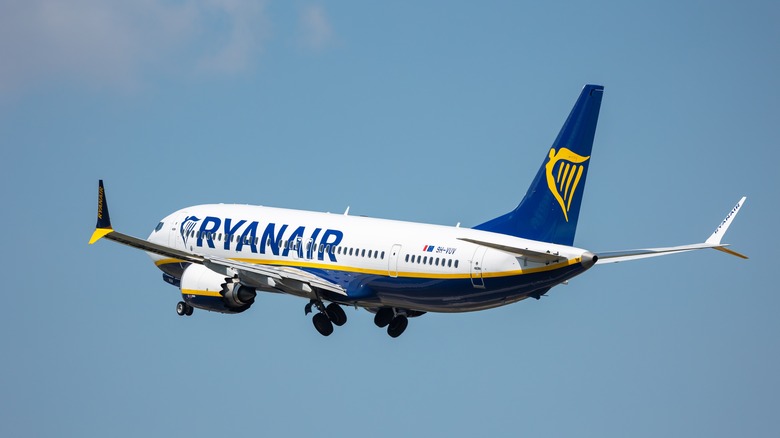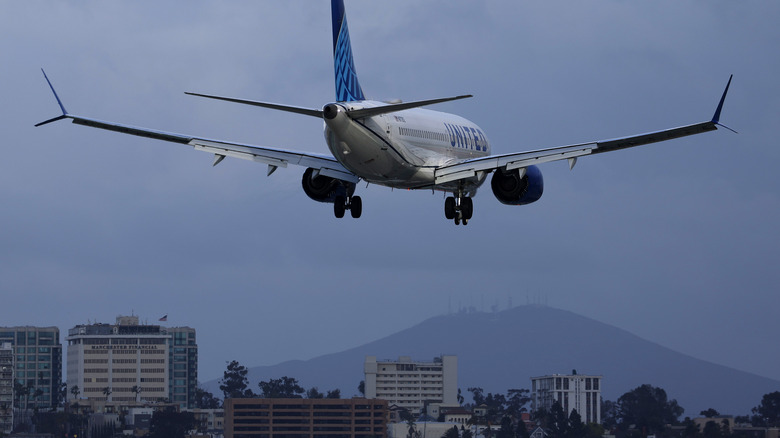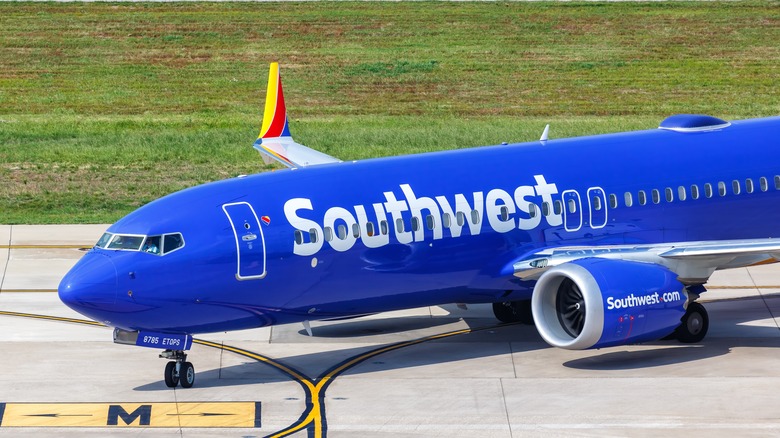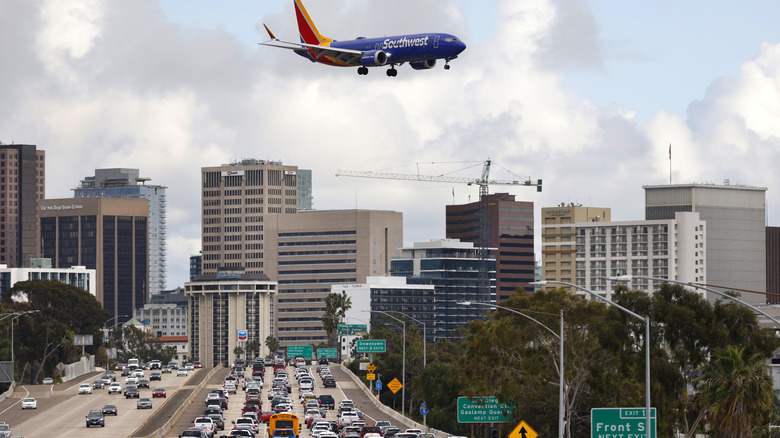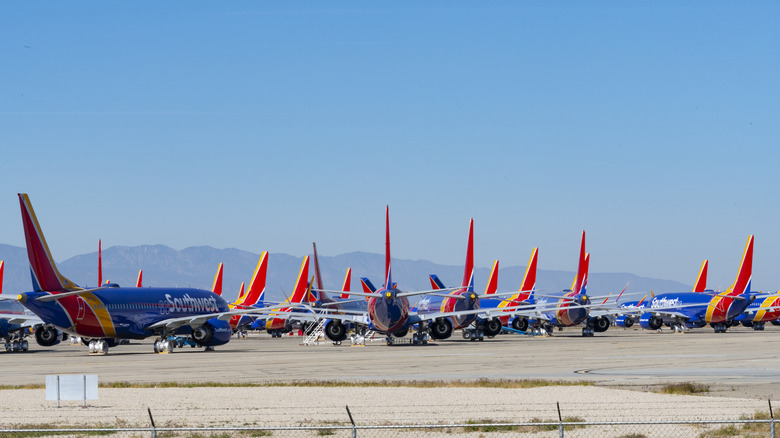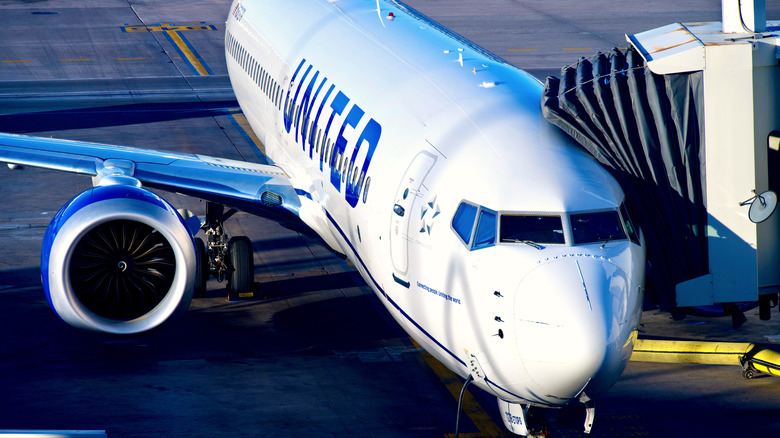Everything To Know About The 737 MAX 8 Jet
There are some rather obscure aircraft that only true enthusiasts will really appreciate, but others can easily be identified from a distance, without the help of an informative companion or museum notice. Boeing's 737, with its distinctive design, is one such example.
Created as a versatile model of a subtler size than a lot of hefty airliners, it became the company's most frequently used aircraft family. Since it was first produced in the '60s, more than 10,000 members of the 737 family have been built. Sadly, though, the aircraft's history hasn't always been a happy one, and the 737 MAX family in particular has been subject to a lot of media attention after some troubling and tragic accidents it was involved in. It's even been possible to exclude the Boeing 737 MAX 9 plane when booking flights on Kayak — which isn't a good look at all.
With the 737 MAX 8 being a very significant case study, we'll review the story of the 737, including how its specs evolved as the wider family did, how widespread its use became, and how certain safety concerns may impact its legacy.
Boeing creates the 737
During the 1960s, the increasing affordability of flying and the success of influential and now-iconic airliners such as Boeing's 727 seemed to demonstrate to the company one key thing: Narrow-bodied airliners would have a not-so-slender place in the industry that was worth pursuing.
The 727's pacey and practical flight (it could reach 632 mph in its original production guise), would be carried forward into the model that built upon it: the 737. Designed to be roughly half the size with a shorter range, the 737-130 could carry up to 114 passengers and had a slower max speed at 575 mph. Performance enhancements continued through four different generations of 737, including the CFM-56-equipped Next-Generation 737-700, -800, and -900, the last of which joined Alaska Airlines in May of 2001. The Boeing 737-900 offered seating for up to 220 people, could travel approximately 2,672 miles, and hit a max cruising speed of around 528 mph. These models all set the stage for Boeing's next step: the formidable MAX line.
The Boeing 737 MAX generation and the MAX 8 take to the air
After Boeing's initial 737, the next generation was the MAX series. This single-aisle aircraft family consists of the 737-7, -8, -9, and -10. The 737-7 actually wasn't the first to arrive: Despite the numerical inconsistency, the MAX 8 took to the air first in January of 2016. The goal of this testing period was to develop an aircraft that could outperform the competition and pique the interest of buyers around the world.
A Boeing press release at the time declared that the MAX would ultimately cost 8% less per seat in operational costs compared to Airbus's A320neo. Ray Conner, Boeing's CEO and Commercial Airplanes President, was quoted as promising that the MAX would "deliver unprecedented fuel efficiency in the single-aisle market for our customers."
In terms of its specifications, the MAX 8 offers a cruising pace of 606 mph and a range of about 4,039 miles. Powered by the LEAP-1B engines characteristic of the MAX family, it emits up to 12% fewer carbon emissions than fellow narrow-bodied aircraft. Next, we'll take a look at some of the unique features the MAX 8 boasts, and how its service history took shape at the start of its life.
Airlines embraced the MAX 8 design
The LEAP-1B engines employed by the 8 and the wider MAX family (two of them apiece) necessitated the fuselage of the aircraft to be reinforced. The MAX's practical design wasn't just centered around weight-bearing, however, but around efficiency more widely. To this end, adjustments like longer and sleeker tail elements were made to provide airflow benefits, thereby allowing for more cost-effective operation.
Unsurprisingly, the promise of a fleet of aircraft that would cost less to run was one that would attract numerous airlines. The first of them was not a domestic carrier: Avolon delivered the first ever production MAX 8 to Malindo Air in May 2017. Avolon CEO, Chandran Rama Muthy, saluted the model's efficiency and range by noting, "these new aircraft will allow us to go to further destinations and will play a key role in providing lower air fares to our customers."
By March 2024, Boeing's MAX family was serving airlines around the world, although the MAX had officially been removed from the model name by this time. The 737-9 was operated on airlines like Indonesia's Lion Air and Flydubai (both with a trio of 9s apiece), along with Alaska Airlines and United Airlines, which boasted the biggest fleets with 65 and 79 of these aircraft, respectively. The MAX 8 was also fielded by Ireland's Ryanair and the British Tui. However, popular as it has been, the MAX family has also been forever affected by some well-publicized recent tragedies.
Tragic accidents befell Boeing's MAX aircraft family
The Malaysian airline Malindo Air was the first to receive a 737 MAX 8 back in 2017. Relaunched as Batik Air in April 2022 and owned by Lion Air , Malindo would be the airline to suffer the first 737 MAX 8 tragedy. On October 29, 2018, Flight 610 left the Indonesian capital of Jakarta, en route to Sumatra. The Lion Air Max 8 had not long taken off when it crashed into the ocean, resulting in the deaths of all 189 passengers on board.
Just over a year after the tragedy, the Indonesian National Transportation Safety Committee concluded that the aircraft's Maneuvering Characteristics Augmentation System (MCAS) was to blame. This system is essentially designed to support pilots by automatically adjusting the plane and ensuring it remains stable in a wide range of operating conditions. However, failures in this system led the aircraft on a downward trajectory and pilots hadn't been trained to adjust in time.
Then, in March 2019, another MAX 8 tragedy occurred: Ethiopia Airlines flight 302 crashed in similar circumstances with another 157 people killed. The Aircraft Investigation Bureau of Ethiopia again found the MCAS' misleading warnings and direction of the aircraft to be a primary cause of the tragedy. Three days after the crash of the Ethiopia Airlines flight, Boeing's MAX repertoire was forbidden from flying pending a resolution of the issue.
The legacy of the MAX 8 and its family
Toward the end of March 2019, Boeing announced its plans for an adjustment to the MCAS system software, and the company said it had resolved these issues and taught pilots how to adjust to the system. Trust in the MAX aircraft would start to return. The Federal Aviation Administration approved the planes for the skies again in November 2020, and by June of 2021, the Boeing 737 MAX aircraft family had largely returned to service. However, more issues were to come. In January 2024, a door plug broke from another MAX 9 on Alaska Airlines flight 1282 moments into its journey to Ontario, California. All on board survived, but it led to an FBI investigation into the degree of Boeing's culpability. Eventually, the National Transportation Safety Board (NTSB) found the Boeing 737 Max 9 may have lacked critical door bolts in the first place.
Boeing's disastrous plane safety record definitely had serious consequences, but the company has not been abandoned by the industry. In November 2023, Ethiopian Airlines purchased almost three dozen new 737s. Boeing started offering "the lowest cost per seat of any single-aisle airplane" through the MAX 10. In March, the company also announced it would give bonuses for employees that made significant contributions to meeting new safety standards. Time will tell if the company can return to the safety reputation it once had.
